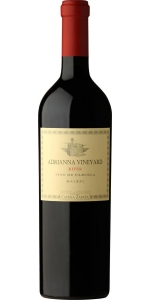Wine from Catena Zapata
Great wines begin in the vineyard. Our vision is to make rich and unforgettable wines that are true to the special place they come from. The story of Catena is the story of Argentine wine.
Founded in 1902, Argentina’s Bodega Catena Zapata is known for its pioneering role in resurrecting Malbec and in discovering extreme high altitude terroirs in the Andean foothills of Mendoza.
The family’s Adrianna Vineyard at almost 5,000 feet elevation has been called the Grand Cru of South America.
Awards: Decanter Man of the Year, Wine Spectator Distinguished Service Award, Der Feinschmaker Award, Wine and Spirits and Wine Enthusiast Winery Awards.
This wine is floral, exuberant, with lengthy smooth tannins, and metallic notes.
This cuvée takes its name from a small parcel of the Adrianna Vineyard that is completely covered with oval white stones and was the site of an ancient riverbed. The abundant stones provide optimal drainage and extreme temperatures. They absorb heat and moderate the nights, but also function like ice cubes after a very cold night. Stony soil Malbecs tend to be extremely aromatic, rich and luxurious, just like the River Malbec from Adrianna. This wine can be enjoyed young or aged for decades.
Pair with grilled meats.
Review:
Wild blackberries, pine cones, bark, chili chocolate, cracked pepper, cloves, iodine and crushed stones on the nose. Full-bodied with firm, creamy tannins. Lovely coolness and minerality to the dark fruit. Powerful, too. Try in 2026.
-James Suckling 98 Points
This wine is floral, exuberant, with lengthy smooth tannins, and metallic notes.
This cuvée takes its name from a small parcel of the Adrianna Vineyard that is completely covered with oval white stones and was the site of an ancient riverbed. The abundant stones provide optimal drainage and extreme temperatures. They absorb heat and moderate the nights, but also function like ice cubes after a very cold night. Stony soil Malbecs tend to be extremely aromatic, rich and luxurious, just like the River Malbec from Adrianna. This wine can be enjoyed young or aged for decades.
Pair with grilled meats.
Review:
There is an usual stony austerity in the 2021 Adrianna Vineyard River, cropped from a cold year when the full clusters fermented in concrete with a slightly shorter maceration and an élevage in a 2,000-liter oak foudre and the rest in stainless steel. It has a moderate 13.4% alcohol with very high acidity (8.2!) and a low pH (3.37), incredible parameters of freshness. The wine was closed and took time to take off in the glass, revealing a very elegant and subtle personality, with the silky texture of the very fine tannins, pristine aromas and flavors and a sense of harmony that was moving. It's powerful but extremely elegant in that rare combination of clout and energy, a wine of light, aerial, with some ethereal qualities, delicate and refined. This combines the cool place and high altitude, the cool year and the stony soils, to deliver a stunning Malbec that goes well beyond the variety. Bravo!
-Wine Advocate 100 Points
- back
Selected Options
Wineries
Categories
Pricing
Countries
Regions
Grape Types
Wineries
Organic/Free Shipping
Winemaking
100% single block Cabernet Sauvignon. Aged 20 months in 100% new French oak.
Place
This beautiful block sits on the lower section of the Red Mountain side of the vineyard. Featuring a perfect southwest aspect, it gets the maximum sun exposure for depth and concentration. The land itself is wind-blown loess covering an alluvial floodplain, dotted with indigenous sage.
Winemaker's Notes
Explosively and exotically nuanced aromas of crème de cassis, Himalayan blackberry, black roses, dried violets, pencil shavings, crushed volcanic rock, and liquefied river minerals. While extremely dense and concentrated, this wine has a lot of grace and poise on the palate. The finish of inky deep black fruits, richly refined oak tones, and exotic floral notes, is utterly bewitching. Leave it for 5-7 years if you can or decant well before drinking. This is a 30-year wine in the making.
Review:
Lastly, and a wine that stopped me in my tracks, the 2021 Cabernet Sauvignon Block 47 might be the wine of the vintage. Revealing a dense purple hue as well as incredible aromatics of caramelized red and blue fruits, classy oak, lead pencil shavings, and a Latour-like sense of minerality, it hits the palate with full-bodied richness, building tannins, a stacked mid-palate, and a great, great finish. I love its balance and purity, but I suspect it’s going to demand bottle age.
-Jeb Dunnuck 97-99 Points
Liminal WeatherEye Vineyard The Mountain Tower is made from 40% Cabernet Franc, 33% Cabernet Sauvignon and 27% Merlot.
All three of these blocks lie quite close together on the steep north-facing side of WeatherEye. Here, full ripeness is reached while preserving great varietal character and lively acidity.
Elegant and evocative aromas of red and black currants, dark plum, violet, Ugandan chocolate, wild tobacco, crushed vanilla bean, and dried thyme. Suave and poised on the palate, with beautifully complex black and blue fruit compote, crushed wild roses, clean tilled dark earth, and windblown herbs. This wine, though drinking great now, is still gathering power, and will age gracefully for many years to come.





